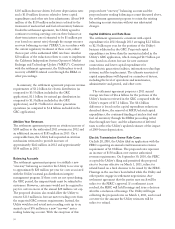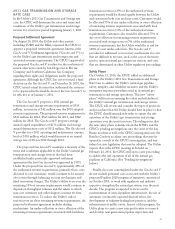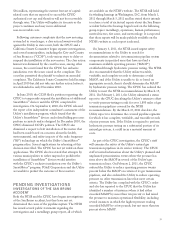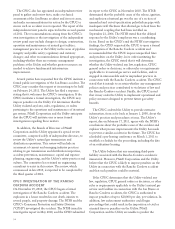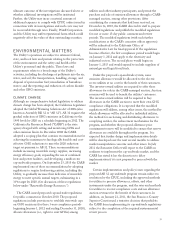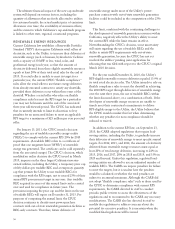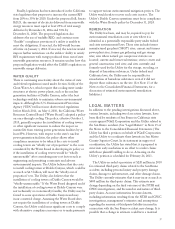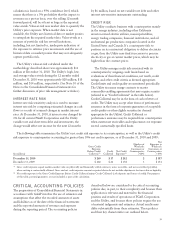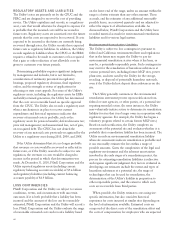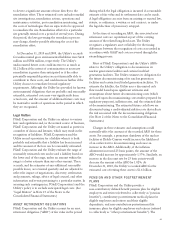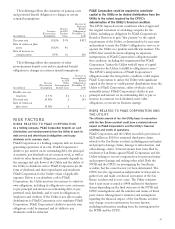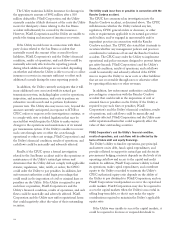PG&E 2010 Annual Report Download - page 42
Download and view the complete annual report
Please find page 42 of the 2010 PG&E annual report below. You can navigate through the pages in the report by either clicking on the pages listed below, or by using the keyword search tool below to find specific information within the annual report.adverse impact on PG&E Corporation’s and the Utility’s
financial condition, results of operations, or cash flows.
In addition to these lawsuits, a purported shareholder
derivative action also has been filed to seek recovery on
behalf of PG&E Corporation and the Utility for alleged
breaches of fiduciary duty by officers and directors, among
other claims.
PG&E Corporation also received a letter, dated
October 4, 2010, on behalf of a purported shareholder,
demanding that the PG&E Corporation Board of Directors
(1) institute an independent investigation of the San Bruno
accident and related alleged safety issues; (2) seek recovery
of all costs associated with such issues through legal
proceedings against those determined to be responsible,
including board members, officers, other employees, and
third parties; and (3) adopt corporate governance initiatives
and safety programs. The Board of Directors of PG&E
Corporation has appointed a committee of independent
directors to evaluate this demand and to make a
recommendation to the Board on its responses to this
demand.
PG&E Corporation and the Utility cannot predict the
outcome of these matters.
PG&E Corporation and the Utility also are named as
parties in a number of claims and lawsuits that have arisen
in the ordinary course of business. In addition, the Utility
can incur penalties for failure to comply with federal, state,
or local statutes. The accrued liability for legal matters
(other than third-party liability claims related to the San
Bruno accident as discussed above) totaled $55 million at
December 31, 2010 and $57 million at December 31, 2009,
and is included in PG&E Corporation’s and the Utility’s
current liabilities – other in the Consolidated Balance
Sheets. See “Legal Matters” in Note 15 of the Notes to the
Consolidated Financial Statements.
RISK MANAGEMENT ACTIVITIES
The Utility and PG&E Corporation, mainly through its
ownership of the Utility, are exposed to market risk, which
is the risk that changes in market conditions will adversely
affect net income or cash flows. PG&E Corporation and
the Utility face market risk associated with their operations;
their financing arrangements; the marketplace for
electricity, natural gas, electricity transmission, natural gas
transportation, and storage; other goods and services; and
other aspects of their businesses. PG&E Corporation and
the Utility categorize market risks as “price risk” and
“interest rate risk.” The Utility is also exposed to “credit
risk,” the risk that counterparties fail to perform their
contractual obligations.
The Utility actively manages market risks through risk
management programs designed to support business
objectives, discourage unauthorized risk-taking, reduce
commodity cost volatility, and manage cash flows. The
Utility uses derivative instruments only for non-trading
purposes (i.e., risk mitigation) and not for speculative
purposes. The Utility’s risk management activities include
the use of energy and financial instruments such as forward
contracts, futures, swaps, options, and other instruments and
agreements, most of which are accounted for as derivative
instruments. Some contracts are accounted for as leases.
On July 21, 2010, President Obama signed into law new
federal financial reform legislation, the Dodd-Frank Wall
Street Reform and Consumer Protection Act. PG&E
Corporation and the Utility are evaluating the new
legislation, and will review future regulations to assess
compliance requirements as well as potential impacts on
the Utility’s procurement activities and risk management
programs.
PRICE RISK
The Utility is exposed to commodity price risk as a result
of its electricity and natural gas procurement activities,
including the procurement of natural gas and nuclear fuel
necessary for electricity generation and natural gas
procurement for core customers. As long as the Utility can
conclude that it is probable that its reasonably incurred
wholesale electricity procurement costs and natural gas
costs are recoverable, fluctuations in electricity and natural
gas prices will not affect earnings but may impact cash
flows. The Utility’s natural gas transportation and storage
costs for core customers are also fully recoverable through
a ratemaking mechanism.
The Utility’s natural gas transportation and storage costs
for non-core customers may not be fully recoverable. The
Utility is subject to price and volumetric risk for the
portion of intrastate natural gas transportation and storage
capacity that has not been sold under long-term contracts
providing for the recovery of all fixed costs through the
collection of fixed reservation charges. The Utility sells
most of its capacity based on the volume of gas that the
Utility’s customers actually ship, which exposes the Utility
to volumetric risk.
The Utility uses value-at-risk to measure the
shareholders’ exposure to price and volumetric risks
resulting from variability in the price of, and demand for,
natural gas transportation and storage services that could
impact revenues due to changes in market prices and
customer demand. Value-at-risk measures this exposure
over a rolling 12-month forward period and assumes that
the contract positions are held through expiration. This
38




